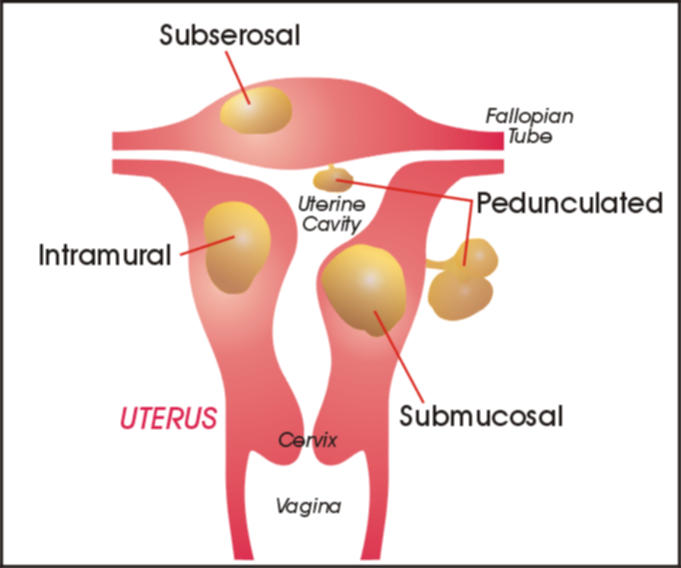Uterine fibroids are among the most common tumors in women. These noncancerous growths of the uterus may appear during your childbearing years. Also called fibromyomas, leiomyomas or myomas, uterine fibroids aren’t associated with an increased risk of uterine cancer and almost never develop into cancer. Most of the time, uterine fibroids aren’t harmful.
As many as three out of four women have uterine fibroids, but most are unaware of them as they often cause no signs or symptoms. Your doctor may discover them incidentally during a pelvic exam or prenatal ultrasound. Fibroids cause problems for about one in four women, most frequently during their 30s or 40s
Sign and symptom
When signs and symptoms of uterine fibroids are present, the most common include
§ Heavy menstrual bleeding
§ Prolonged menstrual periods or bleeding between periods
§ Pelvic pressure or pain
§ Urinary incontinence, frequent urination or urine retention
§ Constipation
§ Backache or leg pains
Rarely, a fibroid can cause acute pain when it outgrows its blood supply. Deprived of nutrients, the fibroid begins to die. Byproducts from a degenerating fibroid can seep into surrounding tissue, causing pain and fever. A fibroid that hangs by a stalk inside or outside the uterus (pedunculated fibroid) can trigger pain by turning on its stalk.
Fibroid location influences your signs and symptoms. Fibroids that grow into the inner cavity of the uterus (submucosal fibroids) are thought primarily responsible for prolonged, heavy menstrual bleeding. Fibroids that project to the outside of the uterus (subserosal fibroids) can press on your bladder or ureters, causing you to experience urinary symptoms. If fibroids bulge from the back of your uterus, they can press either on your rectum, causing constipation, or on your spinal nerves, causing backache
Causes
Uterine fibroids develop from the smooth muscular tissue of the uterus (myometrium). A single cell reproduces repeatedly, eventually creating a pale, firm, rubbery mass distinct from neighboring tissue. Fibroids range in size from seedlings, undetectable by the human eye, to bulky masses that can distort and enlarge the uterus. They can be single or multiple, in extreme cases expanding the uterus so much that it reaches the rib cage.
Doctors don’t know why fibroids occur, but research and clinical experience point to several factors:
§ Genetic alterations. Many fibroids contain alterations in genes that code for uterine muscle cells.
§ Hormones. Estrogen and progesterone, two reproductive hormones produced by the ovaries that stimulate development of the uterine lining in preparation for a possible pregnancy, appear to promote the growth of fibroids. Fibroids contain more estrogen and estrogen receptors than do normal uterine muscle cells.
§ Other chemicals. Substances that help the body maintain tissues, such as insulin-like growth factor, may affect fibroid growth.
Risk Factors
There are few known risk factors for uterine fibroids, other than being a woman of reproductive age. Heredity probably plays a role. If your mother or sister had fibroids, you’re at increased risk of also developing them. Black women are more likely to have fibroids than are women of other racial groups. In addition, black women have fibroids at younger ages, and they’re also likely to have more or larger fibroids.
Research examining other potential risk factors has been inconclusive. Although some studies have suggested that obese women are at higher risk of fibroids, other studies have not shown a link. In addition, limited studies once suggested that women who take oral contraceptives and athletic women may have a lower risk of fibroids, but later research failed to establish this connection. Researchers have also looked at whether pregnancy and giving birth may have a protective effect, but results remain unclear.
Complications:
Although fibroids usually aren’t dangerous, they can cause discomfort and may lead to complications such as anemia from heavy blood loss. Fibroids usually don’t interfere with conception and pregnancy, but they can occasionally affect fertility. They may distort or block your fallopian tubes, or interfere with the passage of sperm from your cervix to your fallopian tubes. Submucosal fibroids may prevent implantation and growth of an embryo. Pregnant women with fibroids are at slightly increased risk of miscarriage, premature labor and delivery, abnormal fetal position, and separation of the placenta from the uterine wall.
In rare instances, fibroid tumors can grow out of your uterus on a stalk-like projection. If the fibroid twists on this stalk, you may develop a sudden, sharp, severe pain in your lower abdomen. If so, seek medical care right away. You may need surgery.
Treatment for Hamorrhage from fibroids.
Fibroid – this is very specific treatment in homoeopathy. You can use with any deep acting medicine for cure of the fibroid.
Trillium pendulum- Uterine hemorrhages with sensation as though hips and back were falling to pieces, better tight bandages. Gusing of bright blood on least movement. Metrorrhagia at menopausal. Lochia suddenly becomes bloody.
Calc Carb –Menses too early too profuse too long uterine fibroid, burning and itching before and after menses.
Thlaspi Bursa Pastoris – Metrorrhagia too frequent and copius menses. Uterine bleeding with violent uterine colic. Every altermate period very profuse. Bloody , dark offensive stains indelibly. Sore pain in womb on rising.. Scarcely recovers from one period before another begins. Uterine fibroids with cramps and expulsion of clots.
Phosphorus –Metritis, chlorosis, frequent and profuse or short uterine bleeding in between the periods in nursing women. Menses too early and scanty not profuse but last too long.
Ustilago – Flabby condition of uterus , hemorrhage, Bleeding fibroids. Tumors have been seen to have disappeared after its use.

